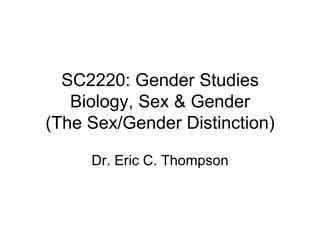Sc2220 Lecture 3 2009
•Transferir como PPT, PDF•
2 gostaram•863 visualizações
Lecture 3: Biology, Sex and Gender
Denunciar
Compartilhar
Denunciar
Compartilhar

Recomendados
Mais conteúdo relacionado
Semelhante a Sc2220 Lecture 3 2009
Semelhante a Sc2220 Lecture 3 2009 (20)
From a Black and White to a Technicolor View of Gender: A Discussion on Gende...

From a Black and White to a Technicolor View of Gender: A Discussion on Gende...
Notes from class · Sex VS. Gender· Sex = Biology Gender = S.docx

Notes from class · Sex VS. Gender· Sex = Biology Gender = S.docx
1 S e x a n d G e n d e r SEX AND GENDER Learni.docx

1 S e x a n d G e n d e r SEX AND GENDER Learni.docx
1 S e x a n d G e n d e r SEX AND GENDER Learni.docx

1 S e x a n d G e n d e r SEX AND GENDER Learni.docx
Mais de socect
Mais de socect (20)
Último
Organic Name Reactions for the students and aspirants of Chemistry12th.pptx

Organic Name Reactions for the students and aspirants of Chemistry12th.pptxVS Mahajan Coaching Centre
Último (20)
Presentation by Andreas Schleicher Tackling the School Absenteeism Crisis 30 ...

Presentation by Andreas Schleicher Tackling the School Absenteeism Crisis 30 ...
Organic Name Reactions for the students and aspirants of Chemistry12th.pptx

Organic Name Reactions for the students and aspirants of Chemistry12th.pptx
Beyond the EU: DORA and NIS 2 Directive's Global Impact

Beyond the EU: DORA and NIS 2 Directive's Global Impact
Disha NEET Physics Guide for classes 11 and 12.pdf

Disha NEET Physics Guide for classes 11 and 12.pdf
Z Score,T Score, Percential Rank and Box Plot Graph

Z Score,T Score, Percential Rank and Box Plot Graph
Web & Social Media Analytics Previous Year Question Paper.pdf

Web & Social Media Analytics Previous Year Question Paper.pdf
Measures of Central Tendency: Mean, Median and Mode

Measures of Central Tendency: Mean, Median and Mode
Sc2220 Lecture 3 2009
- 1. SC2220: Gender Studies Biology, Sex & Gender (The Sex/Gender Distinction) Dr. Eric C. Thompson
- 3. 1. Human Sexual Reproduction and Gender
- 5. Asexual Reproduction (Example: Hydra) (Note: This Hydra, a Mythical Greek Beast, is not what I’m talking about!) Hydra grow “buds” that drop off, grow large, and grow their own buds. Hydra are biologically immortal (they don’t age!). Hydra are small creatures that live in water.
- 6. Sexual Reproduction (1): Sequential and Simultaneous Hermaphrodites Clown Fish: Male to Female Sex Change (Nemo’s deep dark secret?) Wrasse: Female to Male Sex Change Hamlet Fish: Simultaneous Hermaphrodites (Take turns during extended, multiple mating sessions, lasting several days) Banana Slug: Simultaneous Prefers to mate with partner, but self-fertilizes if necessary.
- 7. Sexual Reproduction(2): Heterosexuals Homo sapiens sapiens Hoverflies Rabbits
- 13. 2. Biology, Gender and Cultural Myth-making
- 19. FEMALES MALES 80% 20% 80% In US Army physical tests: top 20% of women had the same average as bottom 20% for men. (These statistics then get used both for and against women in the military) How big is the difference? Example of a test of physical ability; emphasizing upper body strength.*
- 20. How much can you lift? Udomporn Polsak (Female, Thailand, Height 150 cm, Weight 53 kg): Lifted 125 kg* Tang Gonghong (Female, China, Height 172 cm, Weight 120 kg): Lifted 182.5 kg Halil Mutlu (Male, Turkey, Height 150 cm, Weight 56 kg): Lifted 160 kg Hossein Reza Zadeh (Male, Iran, Height 185 cm, Weight 160 kg): Lifted 262.5 kg *All results for “Clean & Jerk” 2004 Olympics
- 23. 3. Sex Differences that Matter in (Some) Social Contexts *Sexual Dimorphism *Reproductive Strategies *Sexual Competition *Hormones
- 32. Biological Differences Matter. But Myths Matter More . Biology is not destiny. Gender is a process we live and a project we construct every day of our lives.
